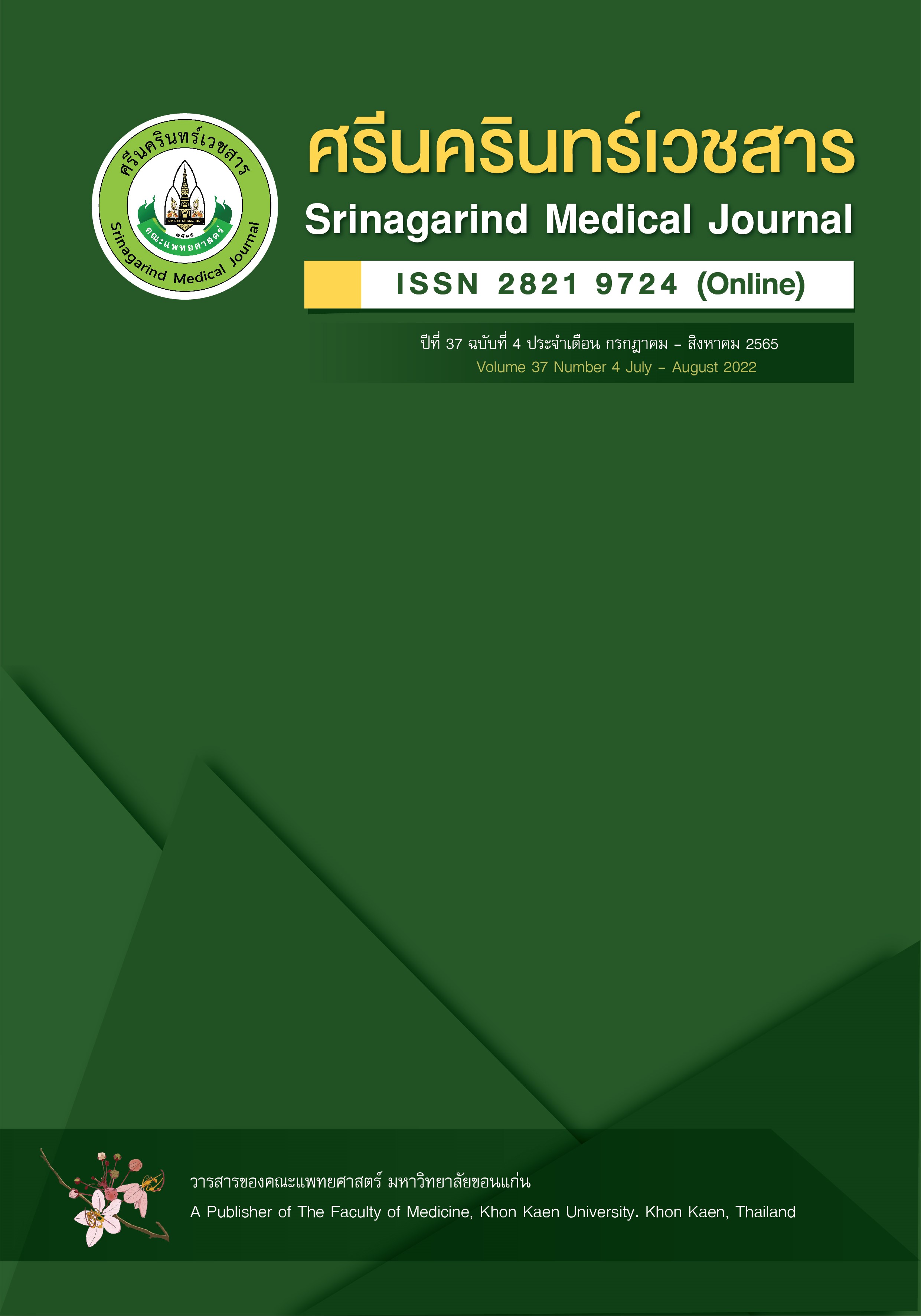ภาวะลิ่มเลือดอุดตันหลังการใช้ยาแอสพาราจิเนส ในผู้ป่วยเด็กมะเร็งเม็ดเลือดขาวลิมโฟบลาสต์และมะเร็งต่อมน้ำเหลือง
คำสำคัญ:
ยาแอสพาราจิเนส , ภาวะลิ่มเลือดอุดตัน , ผู้ป่วยเด็ก , โรคมะเร็งเม็ดเลือดขาวบทคัดย่อ
หลักการและวัตถุประสงค์: ภาวะลิ่มเลือดอุดตันเป็นภาวะแทรกซ้อนรุนแรงที่พบได้ในผู้ป่วยเด็กมะเร็งเม็ดเลือดขาวและมะเร็งต่อมน้ำเหลืองที่ได้รับยาแอสพาราจิเนส วัตถุประสงค์เพื่อหาอุบัติการณ์ ปัจจัยเสี่ยงต่อ ลิ่มเลือดอุดตัน และผลการรักษาภาวะลิ่มเลือดอุดตันหลังการใช้ยาแอสพาราจิเนส
วิธีการศึกษา: เป็นการศึกษาย้อนหลังเชิงพรรณนาในผู้ป่วยเด็กอายุน้อยกว่า 18 ปี ที่มะเร็งเม็ดเลือดขาวลิมโฟบลาสต์และมะเร็งต่อมน้ำเหลืองในโรงพยาบาลศรีนครินทร์ ตั้งแต่เดือน มกราคม 2540 ถึง ธันวาคม 2550 และได้รับการวินิจฉัยภาวะลิ่มเลือด โดยเก็บและวิเคราะห์ข้อมูลทั่วไปของผู้ป่วย อาการของภาวะลิ่มเลือดอุดตัน ปริมาณยาแอสพาราจิเนสสะสม ยากลุ่มแอนทราไซคลินและสเตียรอยด์ที่ได้รับในระหว่างการรักษาด้วยยาแอสพาราจิเนส ภาพทางรังสีวินิจฉัยภาวะลิ่มเลือดอุดตัน ผลการรักษา
ผลการศึกษา: พบว่า ผู้ป่วยเด็กมะเร็งเม็ดเลือดขาวลิมโฟบลาสต์และมะเร็งต่อมน้ำเหลือง 831 ราย ได้รับการรักษาด้วยยาแอสพาราจิเนส เกิดลิ่มเลือดอุดตัน 16 ราย ค่ามัธยฐานอายุ 12 ปี ค่ามัธยฐานระยะเวลาการเกิดลิ่มเลือดอุดตัน 17 วันหลังจากได้รับยา (ช่วงระหว่าง 1 ถึง 41 วัน) โดยพบลิ่มเลือดอุดตันในตำแหน่งหลอดเลือดดำ (ร้อยละ 62.5) มากกว่าหลอดเลือดแดง (ร้อยละ 37.5) โดยที่ 14 ราย (ร้อยละ 87.5) เกิดลิ่มเลือดในระบบประสาท อาการที่พบบ่อยที่สุด คือ ชัก ผู้ป่วยส่วนใหญ่ได้รับยาแอสพาราจิเนสควบคู่กับยากลุ่มแอนทราไซคลินและสเตียรอยด์ ปัจจัยสัมพันธ์การเกิดลิ่มเลือดอุดตัน คือ ภาวะพร่องโปรตีน S ภาวะขาด antithrombin และ โปรตีน C ผู้ป่วยส่วนใหญ่ได้รับการรักษาด้วยยากลุ่มเฮพารินที่มีน้ำหนักโมเลกุลต่ำ (ร้อยละ 81.1) ผู้ป่วย 8 ราย ภาวะลิ่มเลือดอุดตันสลายหมดหลังการรักษา ผู้ป่วย 4 รายพบลิ่มเลือดอุดตันบางส่วน ผู้ป่วย 2 ราย มีอาการดีขึ้น โดยไม่ได้ติดตามด้วยภาพถ่ายรังสี ผู้ป่วย 10 ราย (จาก 14 ราย) มีลิ่มเลือดอุดตันในระบบประสาท มีผลการรักษาดีมาก (ค่าคะแนน modified Rankin scale 0 หรือ 1) 12 รายรอดชีวิต และ 2 ราย เสียชีวิตจากโรคมะเร็งลุกลาม และภาวะสมองขาดเลือด
สรุป: การรักษาโดยใช้ยาแอสพาราจิเนส ในผู้ป่วยเด็กโดยเฉพาะอายุ 10 ปีขึ้นไปที่เป็นโรคมะเร็งเม็ดเลือดขาวลิมโฟบลาสต์และมะเร็งต่อมน้ำเหลืองควรมีการเฝ้าระวังภาวะลิ่มเลือดอุดตัน ปัจจัยเสี่ยงที่พบมากที่สุด คือ ภาวะขาดโปรตีน S ผลการรักษาโรคลิ่มเลือดอุดตันน่าพึงพอใจ การกลับมาใช้ยาแอสพาราจิเนสอีกครั้งค่อนข้างปลอดภัย อย่างไรก็ตาม ปัจจัยเสี่ยงของลิ่มเลือดอุดตันตามหลังการใช้ยาแอสพาราจิเนส และแนวทางในการป้องกันลิ่มเลือดอุดตันหลังจากการใช้ยานี้ ยังต้องการการศึกษาเพิ่มเติมในอนาคต
เอกสารอ้างอิง
Batool T, Makky EA, Jalal M, Yusoff MM. A Comprehensive Review on l-Asparaginase and Its Applications. Appl Biochem Biotechnol 2016;178(5):900–23.
Pui CH, Jackson CW, Chesney C, Lyles S, Bowman WP, Abromowich M, et al. Sequential changes in platelet function and coagulation in leukemic children treated with L-asparaginase, prednisolone, and vincristine. Clin Oncol. 1983;1:380– 5.
Banks JL, Marotta CA. Outcomes validity and reliability of the modified Rankin scale: implications for stroke clinical trials: a literature review and synthesis. Stroke. 2007;38(3):1091–6.
Caruso V, Iacoviello L, Di Castelnuovo A, Storti S, Mariani G, de Gaetano G, et al. Thrombotic complications in childhood acute lymphoblastic leukemia: a meta-analysis of 17 prospective studies comprising 1752 pediatric patients. Blood. 2006;108(7):2216–22.
Van Zaane B, Nur E, Squizzato A, Dekkers OM, Twickler MTB, Fliers E, et al. Hypercoagulable state in Cushing’s syndrome: a systematic review. J Clin Endocrinol Metab. 2009;94(8):2743–50.
Van Zaane B, Nur E, Squizzato A, Gerdes VEA, Büller HR, Dekkers OM, et al. Systematic review on the effect of glucocorticoid use on procoagulant, anti-coagulant and fibrinolytic factors. J Thromb Haemost JTH. 2010;8(11):2483–93.
Truelove E, Fielding AK, Hunt BJ. The coagulopathy and thrombotic risk associated with L-asparaginase treatment in adults with acute lymphoblastic leukaemia. Leukemia. 2013;27(3):553–9.
Qureshi A, Mitchell C, Richards S, Vora A, Goulden N. Asparaginase-related venous thrombosis in UKALL 2003- re-exposure to asparaginase is feasible and safe. Br J Haematol. 2010;149(3):410–3.
Ben Aharon I, Bar Joseph H, Tzabari M, Shenkman B, Farzam N, Levi M, et al. Doxorubicin-induced vascular toxicity-targeting potential pathways may reduce procoagulant activity. PloS One. 2013;8(9):e75157.
Lv H, Tan R, Liao J, Hao Z, Yang X, Liu Y, et al. Doxorubicin contributes to thrombus formation and vascular injury by interfering with platelet function. Am J Physiol Heart Circ Physiol. 2020;319(1):H133–43.
Caruso V, Iacoviello L, Di Castelnuovo A, Storti S, Mariani G, de Gaetano G, et al. Thrombotic complications in childhood acute lymphoblastic leukemia: a meta-analysis of 17 prospective studies comprising 1752 pediatric patients. Blood. 2006;108(7):2216–22.
Athale U. Thrombosis in pediatric cancer: identifying the risk factors to improve care. Expert Rev Hematol. 2013;6(5):599–609.
Journeycake JM, Buchanan GR. Catheter-related deep venous thrombosis and other catheter complications in children with cancer. J Clin Oncol. 2006; 24(28):4575–80.
Malhotra P, Jain S, Kapoor G. Symptomatic Cerebral Sinovenous Thrombosis Associated With L-Asparaginase In Children With Acute Lymphoblastic Leukemia: A Single Institution Experience Over 17 Years. J Pediatr Hematol Oncol. 2018;40(7):e450–3.
Ghanem KM, Dhayni RM, Al-Aridi C, Tarek N, Tamim H, Chan AKC, et al. Cerebral sinus venous thrombosis during childhood acute lymphoblastic leukemia therapy: Risk factors and management. Pediatr Blood Cancer. 2017;64(12).
Risseeuw-Appel IM, Dekker I, Hop WC, Hählen K. Minimal effects of E. coli and Erwinia asparaginase on the coagulation system in childhood acute lymphoblastic leukemia: a randomized study. Med Pediatr Oncol. 1994;23(4):335–43.
Pui CH, Chesney CM, Bergum PW, Jackson CW, Rapaport SI. Lack of pathogenetic role of proteins C and S in thrombosis associated with asparaginase-prednisone-vincristine therapy for leukaemia. Br J Haematol. 1986;64(2):283–90.
Klaassen ILM, Zuurbier CCM, Hutten BA, van den Bos C, Schouten AYN, Stokhuijzen E, et al. Venous Thrombosis in Children with Acute Lymphoblastic Leukemia Treated on DCOG ALL-9 and ALL-10 Protocols: The Effect of Fresh Frozen Plasma. TH Open Companion J Thromb Haemost. 2019;3(2):e109–16.
Mitchell L, Andrew M, Hanna K, Abshire T, Halton J, Wu J, et al. Trend to efficacy and safety using antithrombin concentrate in prevention of thrombosis in children receiving l-asparaginase for acute lymphoblastic leukemia. Results of the PAARKA study. Thromb Haemost. 2003;90(2):235–44.
Greiner J, Schrappe M, Claviez A, Zimmermann M, Niemeyer C, Kolb R, et al. THROMBOTECT – a randomized study comparing low molecular weight heparin, antithrombin and unfractionated heparin for thromboprophylaxis during induction therapy of acute lymphoblastic leukemia in children and adolescents. Haematologica. 2019;104(4):756–65.
Baillargeon J, Langevin A-M, Mullins J, Ferry RJ, DeAngulo G, Thomas PJ, et al. Transient hyperglycemia in Hispanic children with acute lymphoblastic leukemia. Pediatr Blood Cancer. 2005;45(7):960–3.
ดาวน์โหลด
เผยแพร่แล้ว
รูปแบบการอ้างอิง
ฉบับ
ประเภทบทความ
สัญญาอนุญาต
ลิขสิทธิ์ (c) 2022 ศรีนครินทร์เวชสาร

อนุญาตภายใต้เงื่อนไข Creative Commons Attribution-NonCommercial-NoDerivatives 4.0 International License.




